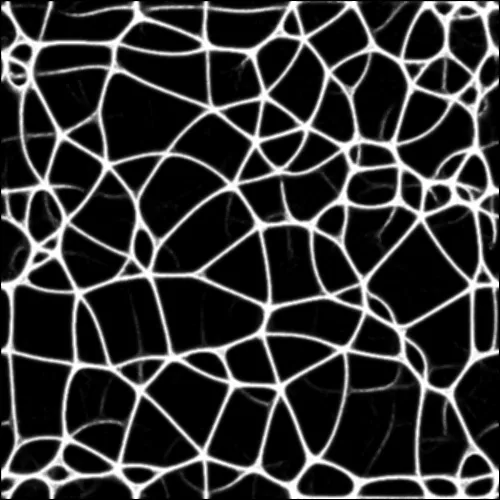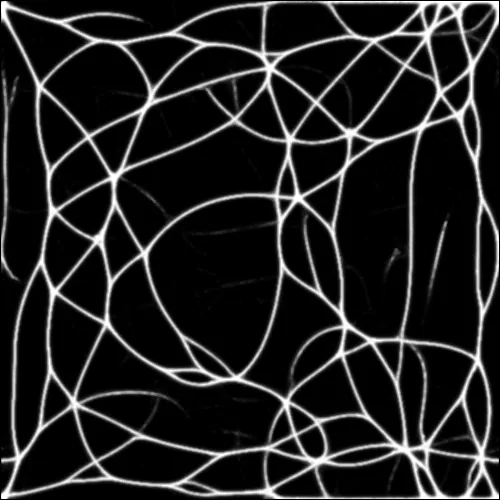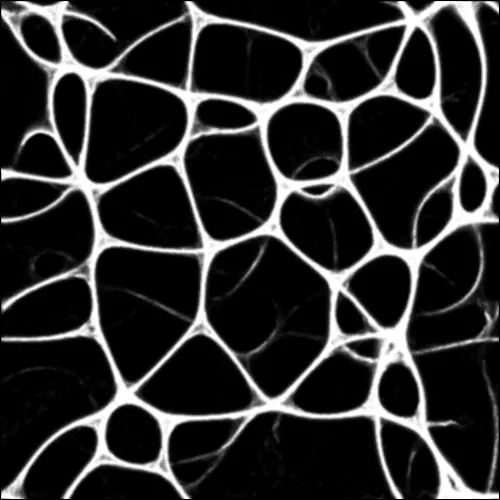Introduction
After watching Sebastian Lague's most recent coding adventure, I was inspired to try my hand at the slime simulations in the 2nd half of the video. This page was another great resource and source of inspiration. I've messed around with generative art before (maybe a future post..) and I think it's one of the coolest things to work on.
The Basics
The previous links explain it pretty well, but just to sum it up:
- a collection of "slime" particles move around and leave a trail everywhere they go
- other particles are attracted to this trail
- the slime trail spreads out and dissipates over time
- the results are quite stunning for such a simple algorithm
The Code
I spent the last few hours writing the code and playing around with settings. It's still pretty basic and probably needs a lot of work, but that's what most of my projects look like. 😉
I tried to leave useful comments (denoted by #$%) and a few options to play around with. It doesn't run very fast because it's just one thread on the CPU, so maybe I'll adapt it with Numba's CUDA functionality later. Anyway, here it is:
import math
import random
import numpy as np
from numba import jit, stencil
from PIL import Image
seed = 0 #$% random seed
random.seed(seed)
step_size = 2 #$% forward motion per timestep
sensor_dist = 10 #$% sensor distance from particle
sensor_angle = math.pi / 8 #$% right and left sensor angle
rotation_angle = math.pi / 8 #$% particle turn angle
deposit_amount = 32 #$% additional intensity per particle per pixel per timestep
decay_factor = 0.75 #$% decay multiplier
step_fudge = 0.05 #$% randomize particle step
angle_fudge = math.pi / 32 #$% randomize particle angle
width = 400 #$% image width
height = 400 #$% image height
particle_count = 2 * width * height
def init_data():
data = np.zeros((particle_count, 3), dtype=np.float32)
for i in range(particle_count):
#$% uniform distribution
data[i] = [
random.uniform(0, width-0), #$% x
random.uniform(0, height-0), #$% y
random.uniform(0, 2*math.pi) #$% angle
]
#$% optional adjustable distribution
# data[i] = [
# random.uniform(4 * width / 10, 6 * width / 10),
# random.uniform(4 * height / 10, 6 * height / 10),
# random.uniform(0, 2*math.pi)
# ]
return data
@jit
def sense(d, trail):
x, y, phi = d
#$% middle sensor
dx1 = sensor_dist * math.cos(phi)
dy1 = sensor_dist * math.sin(phi)
x1 = round((x + dx1) % width)
y1 = round((y + dy1) % height)
s1 = trail[y1, x1]
#$% left sensor
dx2 = sensor_dist * math.cos(phi - sensor_angle)
dy2 = sensor_dist * math.sin(phi - sensor_angle)
x2 = round((x + dx2) % width)
y2 = round((y + dy2) % height)
s2 = trail[y2, x2]
#$% right sensor
dx3 = sensor_dist * math.cos(phi + sensor_angle)
dy3 = sensor_dist * math.sin(phi + sensor_angle)
x3 = round((x + dx3) % width)
y3 = round((y + dy3) % height)
s3 = trail[y3, x3]
return (s1, s2, s3)
@jit
def move(data, trail):
for d in data:
s1, s2, s3 = sense(d, trail)
if (s1 > s2) and (s1 > s3):
#$% keep going straight
pass
elif (s2 > s1) and (s3 > s1):
#$% random turn
d[2] += random.uniform(-rotation_angle, rotation_angle)
elif (s2 > s3) and (s2 > s1):
#$% left turn
d[2] -= rotation_angle
elif (s3 > s2) and (s3 > s1):
#$% right turn
d[2] += rotation_angle
#$% step forward & randomize step
d[0] += step_size * math.cos(d[2]) + random.uniform(0, step_fudge)
d[1] += step_size * math.sin(d[2]) + random.uniform(0, step_fudge)
d[2] += random.uniform(-angle_fudge, angle_fudge) #$% randomize angle
#$% wrap around
d[0] %= width
d[1] %= height
@jit
def deposit(data, trail):
for d in data:
x = min(max(round(d[0]), 0), width - 1)
y = min(max(round(d[1]), 0), height - 1)
#$% increase trail intensity up to max 255 after decay
trail[y, x] = min(trail[y, x] + deposit_amount, int(255 / decay_factor))
@stencil
def kernel(a):
#$% 3x3 average
return (1 / 9) * (
a[0, 0] + a[-1, 0] + a[0, -1] +
a[1, 0] + a[0, 1] + a[-1, -1] +
a[-1, 1] + a[1, -1] + a[1, 1]
)
@jit
def diffuse(a):
#$% apply stencil to the whole array
return kernel(a).astype(np.int16)
@jit
def decay(a):
#$% multiplicative decay
return (a * decay_factor).astype(np.int16)
def do_image(trail):
#$% create image from np array
img = Image.fromarray(trail.astype(np.uint8))
palette = []
for i in range(256):
palette.append(i) #$% red
palette.append(i) #$% green
palette.append(i) #$% blue
# palette.reverse() #$% optional inversion
img.putpalette(palette)
return img
def make_gif(images, name):
#$% make and save animated gif
images[0].save(f'gifs/{name}.gif', save_all=True, append_images=images[1:], optimize=False, duration=40, loop=0)
def main():
images = []
data = init_data()
trail = np.zeros((height, width), dtype=np.int16)
for i in range(500):
move(data, trail)
deposit(data, trail)
trail = diffuse(trail)
trail = decay(trail)
images.append(do_image(trail))
name = f'{seed}_{step_size}_{sensor_dist}_{sensor_angle:.2f}_{rotation_angle:.2f}_{deposit_amount}_{decay_factor}_{width}_{height}_{particle_count}.png'
make_gif(images, name)
images[-1].save(f'pics/{name}') #$% save last image
if __name__ == '__main__':
main()
The Results
Here are a few of the resulting images. There are infinite variations, and I certainly haven't found the best settings yet.



The real magic is in the animations, which are unfortunately hard to show in a post like this. Here's a small sample though. It's so creepily organic. I'll try to render a much larger video and post it in a comment when I can.
Show me what you got
I'd love to see other people play around with the settings, as well as more of this kind of procedural art. Enjoy!
